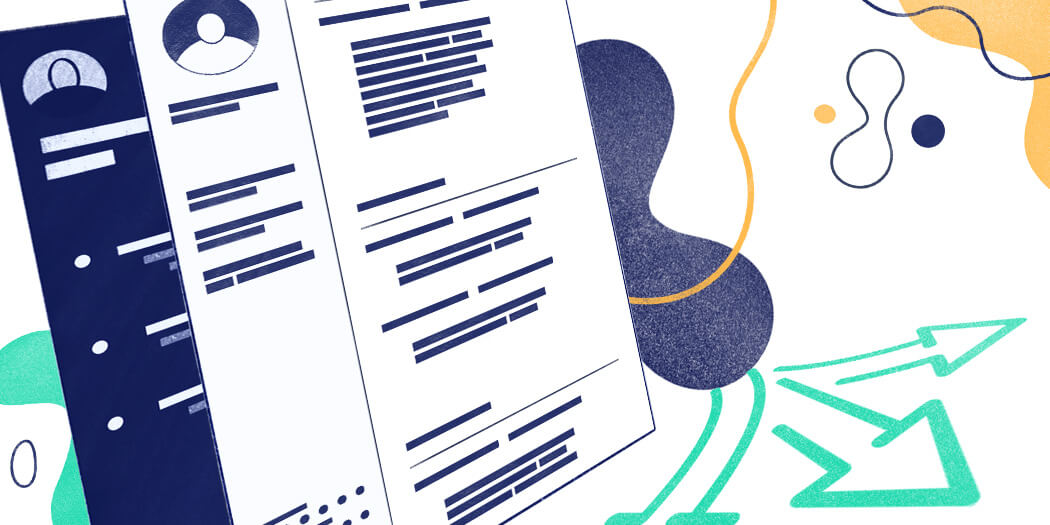
Career Change Resume Examples for 2025 (+Templates & Tips)
You're about to change your career. Learn how to write a career change resume that will get you the dream job.

Tom Gerencer
Career Expert
You know this is what perfection looks like, and your heart beats faster whenever you think of it. Yes, you’ve got a crush on a job ad.
This means you can’t just whip up a resume on a random template and send it in. When applying for your dream job, you need an absolutely perfect resume. So scroll down a bit if you want to learn what makes a perfect resume and create one for your dream job.
Save hours of work and get a job-winning resume like this. Try our resume builder with 20+ resume templates and create your resume now.
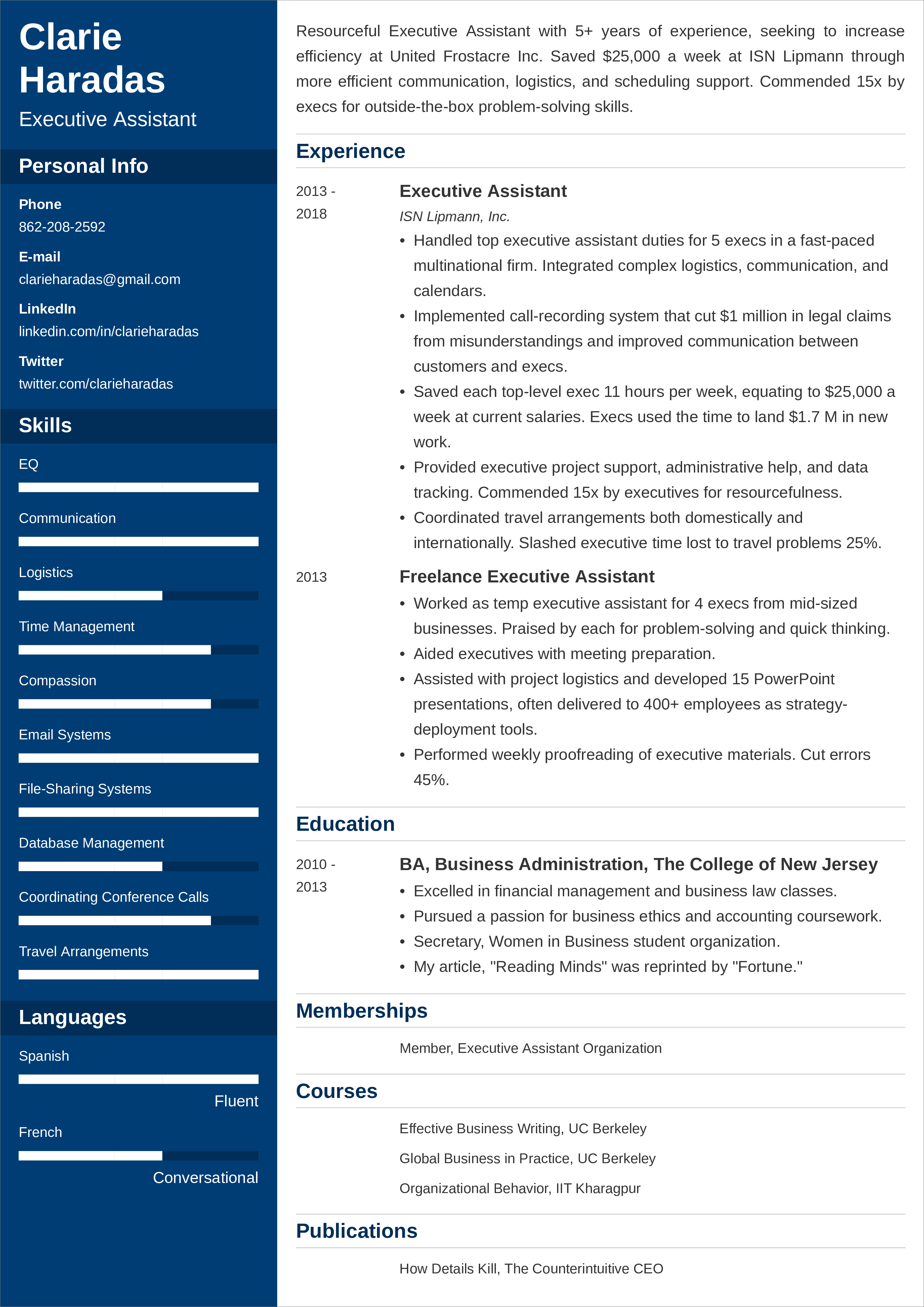
What users say about ResumeLab:
I had an interview yesterday and the first thing they said on the phone was: “Wow! I love your resume.”
Patrick
I love the variety of templates. Good job guys, keep up the good work!
Dylan
My previous resume was really weak and I used to spend hours adjusting it in Word. Now, I can introduce any changes within minutes. Absolutely wonderful!
George
Are you looking for a perfect resume template? Check out these resources:
Is there a secret sauce you can just pour over your resume and make it perfect? Maybe a specific color that acts on recruiters’ minds or a little-known formatting trick that triggers the hiring instinct?
There’s no magic elixir for a perfect resume, but there’s one key thing you need to keep in mind. Without it, your resume won’t be even remotely decent—no matter how perfect the template is.
The perfect resume is perfectly tailored to one specific job ad. Let’s see why.
Each job opening attracts dozens, if not hundreds, of similarly qualified candidates. How do recruiters pick the right one? Do they just choose the person with the most advanced academic degree? The person with the most impressive employment history? Or maybe the candidate with the coolest hobby?
First and foremost, they look for the right person to do one specific job at one specific company.
So they describe their vision of an ideal candidate in the job ad, and your task is to create a resume that fits that vision as precisely as possible by targeting your resume. This is the foundation of a perfect resume. Here’s a short example to show what we mean:
Anna’s dream job is to be a project manager at a civil engineering company. This is part of the job ad:
Here’s how Anna used the keywords and ideas from the job ad to describe one of her previous jobs on her resume:
Senior Project Manager
Road & Bridge Inc., Columbus, OH
January 2018–May 2022
See? Her resume and the job ad fit together like two pieces of a jigsaw puzzle. So, we discussed Anna's example of a perfect resume. Now, let’s create your perfect resume, step by step.
Before crafting those targeted bullet points, let’s look at the big picture first. Which resume format should you use for your perfect resume? Is there a specific resume template that boosts your chances of getting that job?
You’ve got three resume styles to choose from:
The reverse-chronological resume is a resume you’re most familiar with: it starts with your latest job and goes on to describe earlier experiences. It’s the best option for most candidates because it clearly shows career growth and is very easy to read. This makes it the most universally perfect resume format.
On the other hand, the functional resume begins with a detailed list of your skills and achievements that illustrate these skills. The job experience section is short and doesn’t go into much detail.
This can be the perfect format if you’re a freelancer: it lets you put your skills in the spotlight and saves you from the hassle of listing dozens of clients as separate work experiences. It also offers a nice way to gloss over any gaps in employment you don’t really want to talk about.
The chrono-functional, or hybrid resume, is… well, a combination of the functional and the reverse-chronological formats. It has a prominent skills section at the top, followed by a detailed overview of your experience.
The hybrid resume can be tricky to get right, but it can be the perfect option if you’re a seasoned pro targeting a position with a very specific skill set.
However, in most cases, your perfect resume will be a reverse-chronological one. Here’s why:
If you’d like to know more, check our in-depth guide to choosing the ideal resume layout.
Perfect resumes look professional and refined. They also use a page setup that confidently leads the reader’s eye toward your key achievements.
Here’s how to achieve this look:
If you want to skip this step, just opt for a ready-made resume template like the ones in our resume builder.
Expert Hint: Save your resume as a PDF file to preserve all the carefully crafted formatting. DOCX files can look very different when opened on another device, so only submit your resume as a DOCX file if the job ad specifically requires this.
Your resume header is pretty straightforward. It just needs your name, job title, contact info, and links to relevant online profiles, if necessary.
But there’s a difference between a mediocre resume header and a perfect one. Here’s how to write a perfect resume header:
For most recruiters, your work experience is the most important section of your resume. So make sure it’s perfect!
The main thing to remember about the work experience resume section is tailoring it to the specific job ad you’re interested in. Yep, that’s right—if you’re applying for three jobs, you’ll need to create three different versions of your work experience. Sounds like a lot of work. But if you don’t do it, your resume will be somewhere between mediocre and irrelevant—and you need a perfect one, remember?
Here’s how to make the work section of your resume fit a specific job ad like a glove:
But targeting your resume isn’t the only thing to keep in mind. Compare these two examples:
Truck Driver
Fastwheels, Montgomery, AL
May 2019–May 2022
This truck driver focuses on his professional achievements and uses numbers to prove his worth. His accomplishments are highly relevant to what his dream employer needs. After all, what logistics company doesn’t want to save $10,000 in vehicle repair costs and deliver on schedule 98% of the time? Let’s hire this guy straight away!
Truck Driver
Fastwheels, Montgomery, AL
May 2019–May 2022
Is this truck driver good at his job? We don’t know. Maybe he did his best to drive safely and still caused an accident or two. And being “responsible” for maintenance doesn’t mean being good at it. So the recruiter can safely assume that this candidate isn’t worth interviewing.
Point of the story: when writing your perfect resume, focus on specific career achievements and use numbers to describe them wherever possible. You won’t impress anyone by telling them your duties and responsibilities.
Three pieces of advice. One: Keep it short. Read your resume 12 times and cut out at least 10 words after every reading—you’ll find more than 10 if you look closely! Two: Be specific. For example, Supervised a team of 12 auditors or Led $10M CRM implementation project, which was completed 30 days ahead of schedule and 12% under budget. Three: When sending your resume to a US employer, write in the 1st person but don’t use pronouns.
If you need inspiration, check out our collection of resume examples for various positions and careers. You’ll find tons of great examples that will get your resume writing flawless in no time.
The ResumeLab builder is more than looks. Get specific content to boost your chances of getting the job. Add job descriptions, bullet points, and skills. Easy. Improve your resume in our resume builder now.
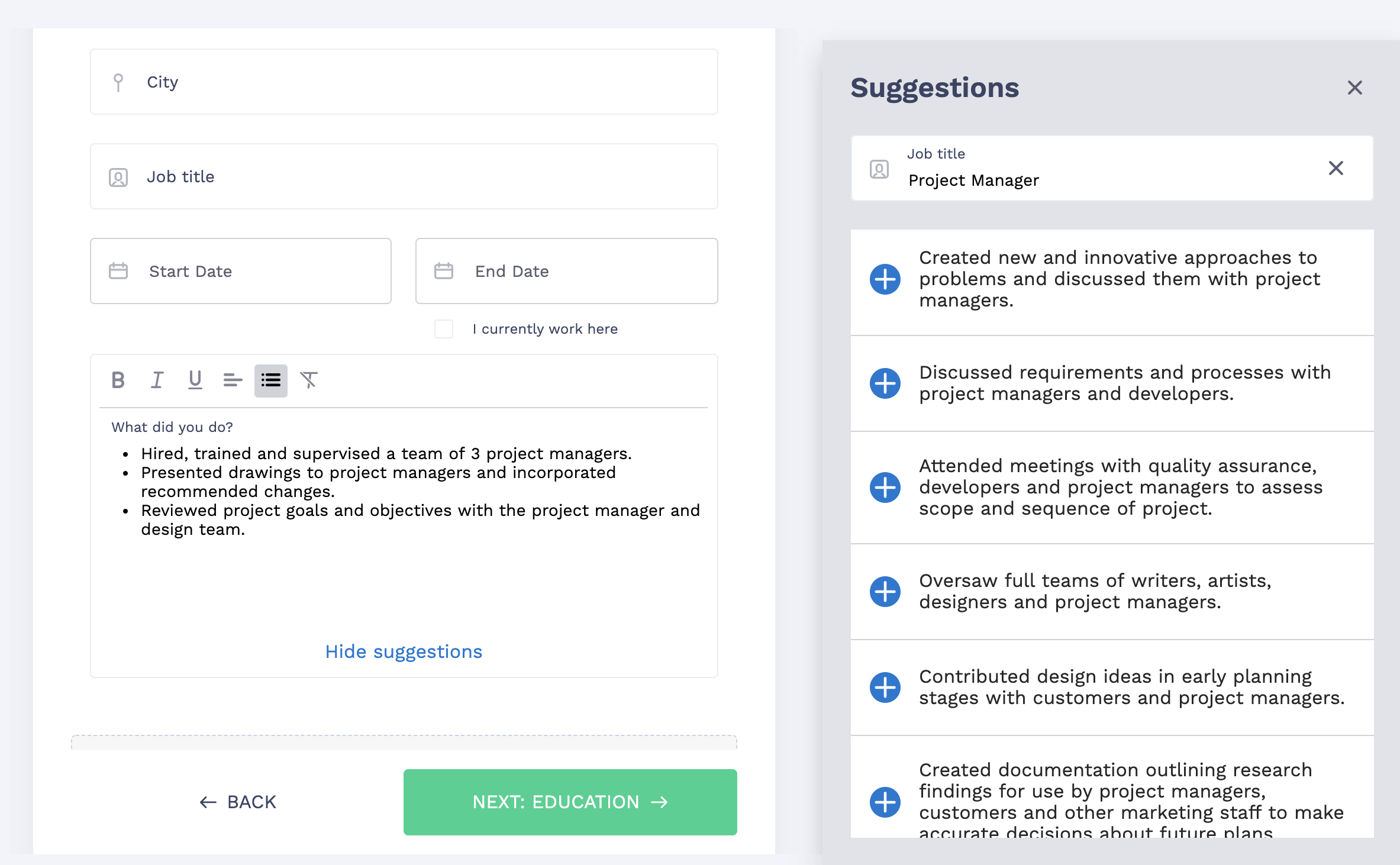
Nail it all with a splash of color, choose a clean font, and highlight your skills in just a few clicks. You're the perfect candidate, and we'll prove it. Use our resume builder now.
Many applicants write resumes with education sections that are either too short or too long. How do you find the perfect length and level of detail for your education section?
The answer is simple: consider how much work experience you have. If you’re a seasoned pro with many work achievements that speak for themselves, keep the education section short and just mention your latest degree or diploma alongside the school and the graduation year.
But if you’re writing a resume for your first job, you need to leverage your education section to prove your worth. Here’s what you can add to your education section to make it more impactful:
Note that the word relevant comes up twice in this list. If you’re applying for a job as a software developer, there’s no need to mention that you took an elective course on conspiracy theories.
If you adjust the length and depth of your education section according to your work experience (or lack thereof), it will be pretty close to perfection. To polish it up, follow our advice in our complete guide to putting education on your resume.
Many candidates treat the skills section of their resume as an afterthought and just throw in a generic skills list they found on Google. And then they wonder why their job applications are often rejected.
But you don’t want to be like them. You’re here to write your perfect resume—with an ideal skills section.
In a reverse-chronological resume, the skills section is a bulleted list of 5–10 keywords. Now, where do you get those keywords from?
Hint: You don’t have to make them up, and you don’t have to copy and paste someone else’s skills list either.
The skills that need to go on your resume are right there in the job ad. Just re-read it carefully and highlight any words that refer to skills. Then, ask yourself which of these skills you actually have.
Got the answer? Now just put those skills on your perfect resume.
Yes, tailoring your skills list to a specific job ad means you’ll have to rewrite your resume for each job you’re applying for. But, as we’ve already mentioned, this effort is necessary if you want your application to come anywhere near the “perfect resume” category.
Ensure that your resume matches up with your experience, education, and qualification information that might be found on your online profiles. If a hiring manager spots any inconsistencies between the two, it may imply that you have something to hide. It can also suggest that you haven’t put the care and attention in that’s expected when applying for a role and that you’re unaware of how to manage your personal online brand effectively.
For a complete step-by-step guide to resume skills, check out our dedicated article on how to put skills on a resume. And if you’re looking for some cool extra tricks to make your resume special, discover our curated list of 50+ best resume tips.
Is there anything else you want to tell your recruiter? Are there any job requirements and expectations that don’t quite fit into work experience, education, or skills?
Well, it’s time to add some more perfect sections to your resume!
For example, you can add interests and hobbies to your resume if they’re relevant to the job. If you want to be a cook at an Italian restaurant, feel free to mention that you’ve traveled across different regions of Italy. Your future boss will know that you can offer patrons authentic dishes prepared with genuine passion.
In fields where additional certifications are crucial, listing certifications on a resume can also be a great idea. You can add your driving license if the employer expects you to have one or mention any foreign languages you speak.
What about adding professional references to your resume? Unless the job ad specifically asks you to submit references as part of your resume, it’s better to prepare the references list as a separate document and only send it in when requested.
Expert Hint: Never lie on your resume. It might be tempting to write that you’ve got unique hobbies and excellent skills in 5 languages, but all the lies will come out during the job interview, and you’ll get rejected immediately.
You might have noticed that we’ve skipped the resume profile—the short paragraph at the top of your resume—for now.
Here’s why: it’s much easier to write a perfect resume profile when you’ve got the rest of your resume laid out.
So, once you’re done with all the other resume sections, it’s time to craft your perfect resume profile. There are two types of resume profiles:
Write a resume summary if you’re an experienced candidate. Mention your years of experience, an epic achievement or two, some key skills, and promise to deliver similar value to your new employer. Like this:
But opt for a resume objective if you’re a junior who wants to win the recruiter’s heart with your powerful motivation and great skills. Explain how you’ll use your skills and passion to help your future employer achieve their business goals.
To make your resume profile truly perfect, follow our dedicated guide. Have a read about a summary of qualifications, too.
So, you've created a perfect resume. You've picked the best resume layout, used all the resume targeting techniques, and proofread your work several times.
But… no matter how perfect your resume is, it won't get you anywhere without an equally perfect cover letter. In fact, 4 out of 10 hiring managers just won’t read your resume if you don’t attach a cover letter!
Double your impact with a matching resume and cover letter combo. Use our cover letter generator and make your application documents pop out.
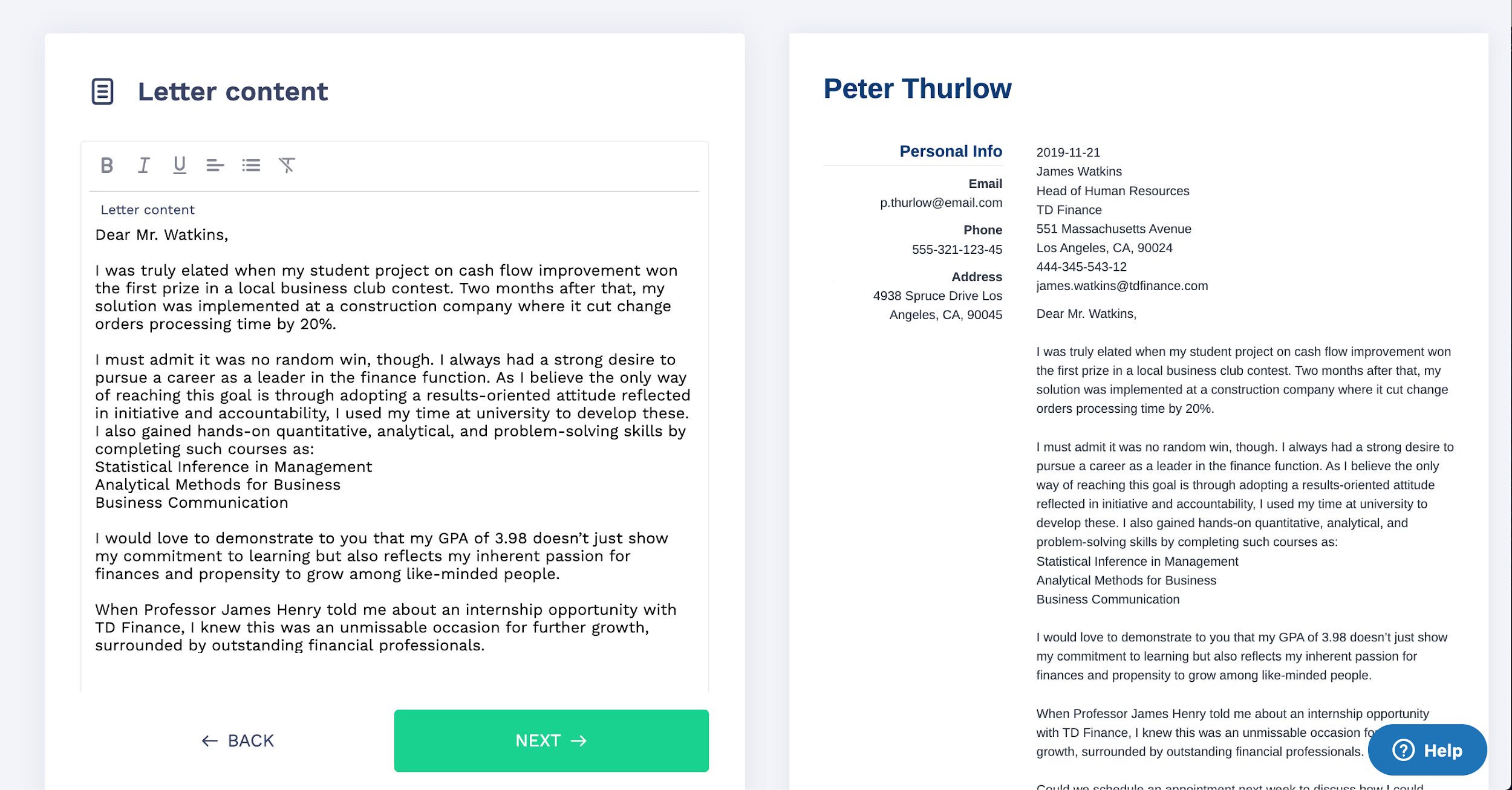
Want to try a different look? There's 21 more. A single click will give your document a total makeover. Pick a cover letter template here.
Writing a cover letter can be quick and easy once you follow our proven procedure. You don't even have to write much—in fact, as few as 250 words can be enough (learn more about the perfect cover letter length in our special guide).
Here’s what you need to know about writing a perfect resume:
Got any questions or maybe a story to tell? Wondering if your resume is perfect enough? Leave us a comment!
At ResumeLab, quality is at the crux of our values, supporting our commitment to delivering top-notch career resources. The editorial team of career experts carefully reviews every article in accordance with editorial guidelines, ensuring the high quality and reliability of our content. We actively conduct original research, shedding light on the job market's intricacies and earning recognition from numerous influential news outlets. Our dedication to delivering expert career advice attracts millions of readers to our blog each year.

You're about to change your career. Learn how to write a career change resume that will get you the dream job.

Tom Gerencer
Career Expert
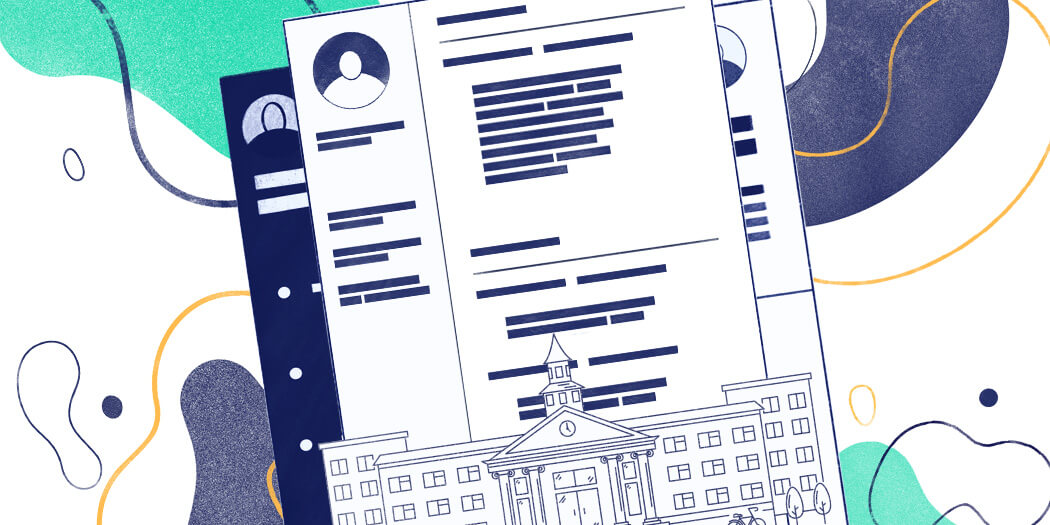
Get ready to rock your student resume game in 2025! We've got the secrets to crafting a resume that'll make employers do a double take.

Maciej Duszynski, CPRW
Certified Professional Resume Writer, Career Expert

To land a perfect job, you need the best-looking resume. This guide will show you what should a good resume look like, and what you need to do to have one.

Maciej Duszynski, CPRW
Certified Professional Resume Writer, Career Expert